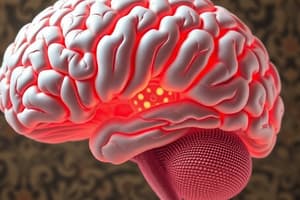Podcast
Questions and Answers
Which descending fibre tract carries voluntary output from the cerebral cortex to the spinal cord?
Which descending fibre tract carries voluntary output from the cerebral cortex to the spinal cord?
- Corticospinal tract (correct)
- Vestibulospinal tract
- Corticobulbar tract
- Reticulospinal tract
Which part of the brainstem subserves 'special senses' like hearing and balance?
Which part of the brainstem subserves 'special senses' like hearing and balance?
- Motor nuclei
- Lumbar cord
- Cervical cord
- Reticular formation (correct)
In the brainstem, what type of information do the white matter tracts carry rostrally and caudally?
In the brainstem, what type of information do the white matter tracts carry rostrally and caudally?
- Both sensory and motor caudally
- Motor rostrally, sensory caudally
- Sensory rostrally, motor caudally (correct)
- Both sensory and motor rostrally
How does the grey matter in the brainstem differ from the grey matter in the spinal cord?
How does the grey matter in the brainstem differ from the grey matter in the spinal cord?
Which cranial nerve controls the sternocleidomastoid (SCM) and trapezius muscles?
Which cranial nerve controls the sternocleidomastoid (SCM) and trapezius muscles?
Through which foramen does the hypoglossal nerve exit the cranium?
Through which foramen does the hypoglossal nerve exit the cranium?
Which division of the trigeminal nerve conveys somatic sensation from the face via the superior orbital fissure?
Which division of the trigeminal nerve conveys somatic sensation from the face via the superior orbital fissure?
What type of fibers exit the skull via the stylomastoid foramen to innervate muscles of facial expression?
What type of fibers exit the skull via the stylomastoid foramen to innervate muscles of facial expression?
Nerve damage to which cranial nerve causes Bell Palsy?
Nerve damage to which cranial nerve causes Bell Palsy?
Which cranial nerve is responsible for voluntary motor to a single pharyngeal muscle?
Which cranial nerve is responsible for voluntary motor to a single pharyngeal muscle?
From which foramen does the vagus nerve exit the cranium?
From which foramen does the vagus nerve exit the cranium?
Which type of sensory fibers does the vagus nerve carry from the laryngopharynx and larynx?
Which type of sensory fibers does the vagus nerve carry from the laryngopharynx and larynx?
Nerve damage to which cranial nerve can affect the carotid body and carotid sinus?
Nerve damage to which cranial nerve can affect the carotid body and carotid sinus?
The trigeminal ganglion contains the cell bodies of which type of neurons?
The trigeminal ganglion contains the cell bodies of which type of neurons?
Which cranial nerve conveys somatic sensation from the face via the foramen rotundum?
Which cranial nerve conveys somatic sensation from the face via the foramen rotundum?
Nerve damage to which cranial nerve can cause voluntary motor impairment to the four muscles of mastication?
Nerve damage to which cranial nerve can cause voluntary motor impairment to the four muscles of mastication?
Which part of the brainstem connects the spinal cord to the cerebellum and cerebral cortex?
Which part of the brainstem connects the spinal cord to the cerebellum and cerebral cortex?
What does the cerebellum primarily control?
What does the cerebellum primarily control?
Which type of input does the cerebellum receive?
Which type of input does the cerebellum receive?
What do outputs from the cerebellum control?
What do outputs from the cerebellum control?
Which nerve controls extraocular eye muscles?
Which nerve controls extraocular eye muscles?
What specific function does the trochlear nerve control?
What specific function does the trochlear nerve control?
Which cranial nerve conveys auditory sensations and balance information?
Which cranial nerve conveys auditory sensations and balance information?
Which nerve emerges from the upper cervical segments and controls the sternocleidomastoid and trapezius muscles?
Which nerve emerges from the upper cervical segments and controls the sternocleidomastoid and trapezius muscles?
What specific symptoms can result from damage to cranial nerves?
What specific symptoms can result from damage to cranial nerves?
Which part of the brainstem is connected to the cerebellum by superior, middle, and inferior cerebellar peduncles?
Which part of the brainstem is connected to the cerebellum by superior, middle, and inferior cerebellar peduncles?
What type of information do inputs to the cerebellum include?
What type of information do inputs to the cerebellum include?
Which part of the brainstem lies between the midbrain and the medulla?
Which part of the brainstem lies between the midbrain and the medulla?
Flashcards are hidden until you start studying
Study Notes
Anatomy of the Brainstem and Cranial Nerves
- The brainstem connects the spinal cord to the cerebellum and cerebral cortex.
- It consists of the diencephalon, midbrain, pons, and medulla.
- The cerebellum is connected to the brainstem by superior, middle, and inferior cerebellar peduncles.
- The cerebellum controls posture, balance, and coordination of motor function.
- Inputs to the cerebellum include proprioceptive information and vestibulo-cerebellar input.
- Outputs from the cerebellum control body movement through the motor cortex.
- The brainstem and cranial nerves have both sensory and motor components.
- Cranial nerves convey special senses, control skeletal muscles, or have mixed functions.
- The olfactory nerve conveys smell, the optic nerve conveys visual input, and the vestibulocochlear nerve conveys auditory sensations and balance information.
- The oculomotor nerve controls extraocular eye muscles, the trochlear nerve controls eye position, and the abducens nerve controls eye movement.
- The accessory nerve emerges from the upper cervical segments and controls the sternocleidomastoid and trapezius muscles.
- Damage to cranial nerves can cause specific symptoms such as strabismus, diplopia, ptosis, and mydriasis.
Studying That Suits You
Use AI to generate personalized quizzes and flashcards to suit your learning preferences.




